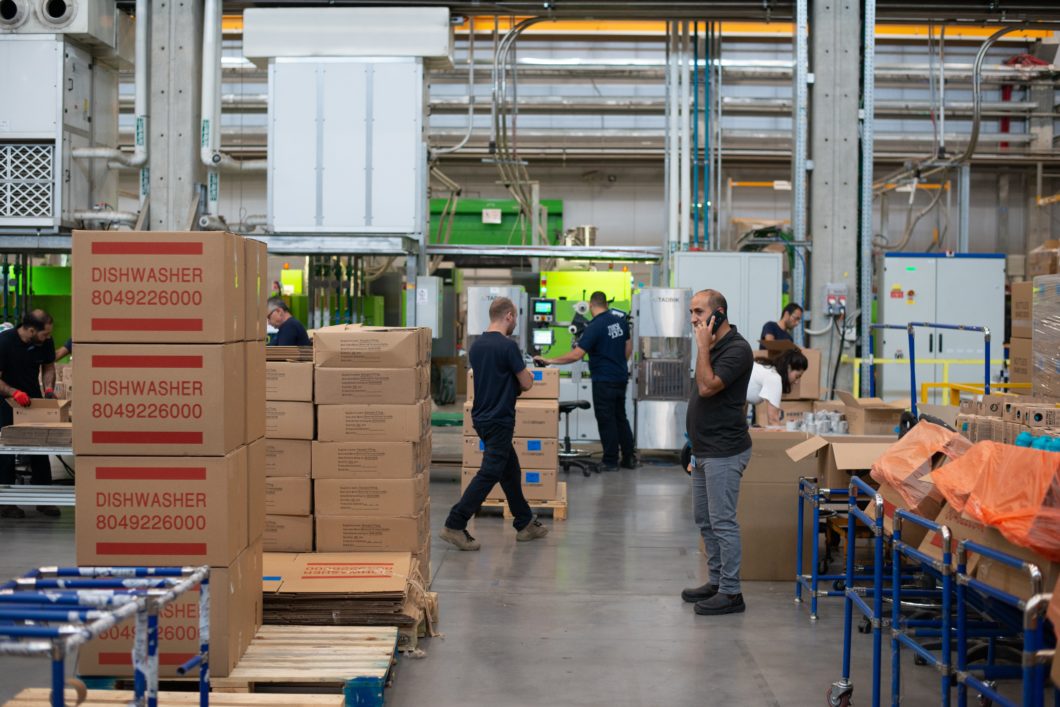Discover the pros and cons of different hybrid working models and get expert tips to successfully implement flexible policies in 2023.
By Making Moves London
December 10, 2022
The onset of the Covid-19 pandemic in 2020 saw a huge number of businesses shift to hybrid work models. And this new way of working looks set to stay, with many businesses now realising its benefits and adopting it in their own way.
What works for each company will depend on what type of business it is, the company culture, and the size of the organisation, amongst other factors.
In this blog post, we’ll take a look at the types of hybrid working models, highlighting benefits and potential challenges, as well as tips for implementing each model successfully.
Before we jump into the pros and cons of each type of hybrid work model individually, it’s helpful to understand its general benefits. These include:
Several studies have linked hybrid working to improved employee productivity. A ConnectSolutions survey, for example, found that 77% of employees who work from home at least a few times per month get more work done.
Many employees say that a hybrid work schedule has improved their work-life balance due to reduced commute times and boosted productivity. The Office for National Statistics found that over three-quarters (78%) of remote and hybrid workers reported an improvement in their work-life balance.
Commute distances once heavily determined where an individual was able to work, but hybrid working has now significantly reduced this limitation. In turn, this has opened up more opportunities for workers and has widened the talent pool for businesses.
The shift to hybrid work has presented businesses with the opportunity to downsize their office space as they no longer need to provide each of their employees with a desk every day of the week. For many, this has seen office costs reduced significantly.
Hybrid work allows employees to reap the benefits of working from home while still enjoying first-rate, in-person collaboration. In-person discussions often give rise to the best ideas and strategies and allow colleagues to feel a stronger sense of connection.
For more information on the benefits of hybrid working, check out Making Moves’ extensive guide on the benefits and challenges of hybrid working.
Primarily, there are three categories of hybrid work models: Work environment, scheduling, and division of employees.
The work environment category pays attention to where a business predominantly wishes its employees to work. The scheduling category, meanwhile, involves assigning employees specific times and days to come into the office. The division of employees category focuses on splitting employees into two groups: Those who are able to perform their job remotely and those who need to be on-site.
There are then five types of hybrid work models that fall within these three categories:
Work environment:
Scheduling:
Division of employees:
In the next section, we’ll take a closer look at these five types of hybrid working models.

Both at-will and remote-first models allow employees to prioritise working from home while retaining the option to go into the office when the need calls them. Examples of big-name companies that have opted for remote-first working include Zapier, Zoom, Reddit, IBM, and Skillshare.
This type of hybrid work model allows employees to remain in control of how frequently they head into the office or work from home, opting for the work practices that are most suited to them and their way of working. While some employees will thrive in an at-home work environment, others may find it very challenging. Leaving this option open to employees, therefore, promotes productivity and helps businesses to get the very best out of each and every one of their staff members.
Maintaining a physical business premises is also highly beneficial for any in-person meetings or necessary face-to-face discussions as well as meeting with clients. Meeting with clients in person can be advantageous over meeting with them over the phone or a video call. Despite technology’s widespread influence, some clients will always prefer meeting face-to-face.
Adopting this type of hybrid work model helps to cultivate a relationship of trust between business leaders and employees, as employees are left to determine when it’s necessary to go into the office. This heightened level of trust can help to improve the morale of employees, boosting feelings of job satisfaction, which can in turn help with productivity.
Nonetheless, there are some disadvantages to at-will and remote-first models. These types of hybrid working can be fairly unpredictable, operationally speaking. It is difficult for businesses to predict when workers may visit the office and how many may visit at a given time. This can lead to overcrowding or, equally, too-large of an office space being rented.
However, these challenges can be managed, such as by asking employees to book their office time in advance and surveying employees for their working preferences.

The office-first model working is similar to at-will and remote-first models in that all employees can either work remotely or work in the office. However, the office-first working model prioritises office presence, with employees expected to show up at the company premises most of the time.
For businesses, office-first hybrid working is generally much easier to implement as it requires fewer adjustments to protocols. Most likely, just a few policies will need tweaking, saving time and money up-front.
Office-first working also carries the benefit of maintaining strong collaboration and teamwork, as employees see one another almost every day, making relaying information much simpler. It reduces the need for scheduled phone and video calls, allowing discussions to occur more organically within the company.
However, there are also challenges that come with the office-first working model. If employees are expected to attend the office most days of the week, then this negatively impacts their work-life balance, with the average UK commute taking 54 minutes. In turn, this can affect productivity.
According to Marchetti’s Law, if remote working eliminated an hour of commuting per day, without changing time spent on work or reducing production, the result would be equivalent to a 13% increase in productivity (assuming a 38-hour working week).
Meanwhile, a 2020 study by Vodafone found that over half (60%) of small business employees, who were then working from home due to the pandemic, used the time they would have spent commuting as work time instead.
Companies that implement an office-first approach to hybrid working may also find they attract a reduced talent pool, with fewer people now happy to attend the office frequently after experiencing remote working during the coronavirus pandemic. Research conducted by Lab Owls suggests that 80% of full-time employees expect to work from home at least three times per week post-covid.
Nonetheless, the office-first working model evidently works well for many, particularly those whose productivity depends on collaboration. Big-name companies that have opted for this type of hybrid working model include investment bank Goldman Sachs, video streaming giant Netflix, and coffee-chain Costa.

The split-week hybrid working model works by assigning specific days for remote work and on-site work.
For example, one company department might work in-office for the first two days of the week, then the last three days of the week at home. Meanwhile, another company department might work at home for the first two days of the week, then in-office for the last three days.
This model of hybrid working can prove beneficial as, by assigning teams specific days to be in-office, overcrowding in the workplace is prevented. Businesses will know exactly when to expect which workers, and how many workers, in the office at any given time. This will ensure all employees have sufficient desk space and tech resources when working in person.
This type of hybrid working also means teams are still presented with plenty of opportunity to meet face-to-face, so in-person collaboration isn’t inhibited.
However, a key challenge of this type of hybrid working model is the reduction in inter-team interaction. While teams have plenty of opportunities to collaborate, the interaction between different teams is very limited, as their working schedules are polar opposites.
This can have a knock-on effect on team building across the company and may, over time, lead to a “them and us” culture.
A further challenge to consider with this type of hybrid working is again the possibility of a reduced talent pool when hiring. Companies that offer their employees greater flexibility through the type of hybrid work model they adopt will generally have a competitive edge. Many employees now expect to choose for themselves which days they attend the office and which days they work from home, in accordance with their own personal needs.
Additionally, because you are giving your employees less flexibility as to when and how many days per week they work from home, there may be a greater expectation for you to shoulder some of your employees’ home working expenses. There may be the expectation for you to assist with electricity bills, heating bills, and home office equipment.
However, many big-name companies are successfully working past these challenges, such as Capital One.

Like the split-week hybrid working model, the week-by-week model also involves assigning team members specific days to attend the office.
In this type of hybrid working model, business leaders assign specific in-office work weeks for when employee groups are required to attend the office. The following week, or weeks, are then spent working from home, while a new group works from the office.
The week-by-week hybrid working model is most advantageous for businesses that employ a large number of people. This setup still promotes collaboration and team building, while also helping a business to significantly reduce the office space required and to cut down on overhead costs.
Yet, the mandated weeks mean businesses can accurately forecast how many employees to expect in the office at any given time, avoiding overcrowding while simultaneously maximising their office space. In this sense, the week-by-week model is very efficient.
However, one of the main problems with this type of hybrid work is its lack of flexibility. For example, an unprecedented issue may occur for a particular team during a week scheduled for home working. While this problem could be more easily resolved if the team was able to meet and collaborate in person, there is no space for them to do so within the office at that time, leaving them to resolve the issue via phone and video calls instead of face-to-face.
Additionally, as with the split-week model, employees have no freedom to decide when they work from home and when they work in the office under this type of hybrid work model. Again, with many people now expecting this choice, and many other companies offering it, this could have a knock-on effect on employee satisfaction. In turn, this could impact retention and may lead to a reduced talent pool.
There is also the risk that the division between teams may lead to a “them and us” culture over time, with inter-team collaboration very much limited.

A business may opt for a hybrid working model according to employee assignments. This might be called a team-specific working model, or a hybrid mix working model.
Under the team-specific working model, employees are told to either work from home or from the office according to which team they work within and the nature of that particular team’s work. This model works well for businesses that require some employees to work in person but not others.
For example, an e-commerce company needs employees to physically pack its goods ready for customer distribution. This team of employees are unable to work remotely. However, at the same company, those who work in admin or IT, with their workload performed via computers, can easily carry out their role from home.
As such, the team-specific hybrid work model boosts efficiency for employees, preventing people from coming into the office unnecessarily. This, in turn, should help to boost their productivity.
Businesses will not only benefit from this improvement in productivity but may also save money on overhead costs. With some teams working from home, electricity and other utility bills will be significantly reduced over time.
Nonetheless, there are also some disadvantages to this type of hybrid working that need to be considered. For example, it may divide on-site and remote-based employees as there is less opportunity for them to connect, and there is also the potential for feelings of jealousy on both sides.
Those who work remotely may feel as though their colleagues are presented with more opportunities for growth, development, and recognition. Meanwhile, those working in person may envy the improved work-life balance of their home-working counterparts.
Both of these factors have the potential to create a “them and us” culture over time, which could be damaging to employee satisfaction and retention.
However, several companies have adopted this type of hybrid working model since the onset of the Covid-19 pandemic, with Amazon serving as one big-name example. Some Amazon workers, such as warehouse workers and delivery drivers, are simply unable to work from home due to the nature of their work.
As already mentioned, there are pros and cons to each type of hybrid working model. Which will work best for you depends on several factors, including your company culture, industry and employee needs, as well as the preferences of your clients.
Whichever option you go for, you should make sure you have a robust policy in place to lay out the necessary foundations.
In addition to these five key types of hybrid working models, many businesses also like to put their own spin on things.
Having spoken out against remote-only work, Microsoft now has a flexible work policy in place that enables employees to work from home 50% of the time. If employees want to increase their remote schedule, they can seek the approval of their manager.
Citigroup, meanwhile, offers a 50/50 split between remote/hybrid and in-office working, but only for some of its employees. Data centre employees as well as branch workers have been required to continue working traditionally.
Lockheed Martin has opted for up to 45% of the company to work hybrid, but managers have had to undergo 20 hours of training to prepare for this new way of working.

In order for any company to successfully implement a hybrid working model, robust policy, strong communication, and consideration for how your employees wish to work are vital. Let’s take a closer look at these factors, as well as several others, in further detail.
Before building a hybrid working model, speak to your employees to learn and understand their needs. Hybrid work must work for everyone. If not, you risk job satisfaction and retention dropping. Ask questions about your employees’ preferred working setup as well as how they currently use the office.
The introduction of a hybrid working model to a workplace will likely require new policies to be put in place or for existing policies to be adjusted. Any new or adapted policies should be clearly communicated, including in employee contracts, and should be issued with supporting guidance so everything can be implemented smoothly.
When implementing a hybrid working model, asynchronous communication is key to ensuring that information is equally dispersed across both in-office and remote-based teams. A newly hybrid business should establish company-wide best practices for communication, making communication an intentional part of everyone’s working day. This will help to reduce friction between remote-based and in-office teams and will help to ensure equal opportunities for all.

Strong IT infrastructure is important for any business, but particularly a business with a hybrid working model. Cybersecurity must be prioritised, as well as tools specifically for project management, team collaboration, brainstorming, team management, and communication. It will also be helpful if meeting rooms can be booked easily via technology and if systems are set up to show office capacity and who is currently working in person. IT must support everyone, whether they are working from home or in the office.
A considered approach to HR can help a hybrid business to assess the needs of all employees and stay alert to the risks of burnout involved with remote working. When the risk of burnout is successfully managed, hybrid working has been shown to have a positive impact on employee wellbeing, with HR teams successfully boosting the mental health of teams. HR departments can help roadmap flexible benefit packages to help boost work-life balance for your employees.
Company culture is a key part of any business. As a hybrid business, you should be intentional about a company culture that supports both remote and in-office working. Consider how you can create experiences for your employees around core values. For example, if one of your core values is teamwork, arrange in-person or virtual team-building activities that everyone can be part of.
As 2022 comes to a close, Director of Operations at Making Moves, Sally Evans, shares her hybrid working predictions for the upcoming year.
Companies that will succeed with hybrid working in 2023 must implement a robust and clear policy as a starting point
Key criteria for being able to identify a suitable property solution is identifying the frequency that people will be coming into the office and the specific days. This will help determine how much space they’ll actually need. This process should be undertaken before going to market and be at the heart of a clear and well-communicated hybrid working policy. We have found that businesses that are seeing success with hybrid are mandating specific days per week rather than an ad-hoc approach and well-established businesses already have concrete plans for hybrid and what this means for their property portfolio.

We have seen large and sustained growth in demand for fitted and flexible space, but with this means there’s more competition. This may mean that businesses aren’t getting great deals because landlords can leverage this increased interest. Businesses that have effectively implemented a hybrid policy and forecasted around space utilisation are reducing their SQFTage.
Because of this, they can find better, smaller and more impressive spaces as they don’t need to account for the full headcount of the business. In turn, there are better deals in the lease-specific property market for non-adopters of hybrid working strategies as there’s less demand for these types of spaces.
We have seen increased demand in remainder leases (sub-lease assignments) which we anticipate will continue, as these have the benefits of a quick turnaround and much lower upfront and exit costs.
When considering which of the several types of hybrid working is most appropriate for your business, weigh up the pros and cons of each carefully. What works for one business won’t necessarily work for yours. Make use of the above tips to ensure a smooth and efficient implementation.
Our team of experienced London-based office space agents are well versed in helping find clear solutions to complex workspace problems in a post-pandemic hybrid working world. Get in touch to find out more about how we can help.

? Source, negotiate and manage entire office moves.
? Dispose, sublet or redesign your office.
?️ Professional, independent support.